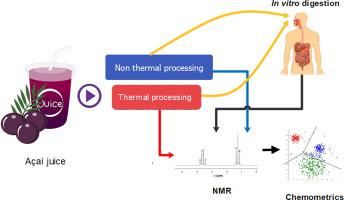Food Research International ( IF 7.0 ) Pub Date : 2020-07-03 , DOI: 10.1016/j.foodres.2020.109506 Maria de Fátima D Linhares 1 , Elenilson G Alves Filho 1 , Lorena Mara A Silva 2 , Thatyane V Fonteles 1 , Nédio Jair Wurlitzer 2 , Edy S de Brito 2 , Fabiano A N Fernandes 3 , Sueli Rodrigues 1

|
This study evaluated the effects of High-Temperature Short Time (HTST), Ultra High Temperature (UHT), and the non-thermal processes High Power Ultrasound (US), UV-pulsed-light and Low Pressure Plasma (LPP) on the composition, stability, and bioactive compounds bioaccessibility of açai juice. 1H NMR based approach, coupled to chemometrics, was applied to evaluate the changes in the juice composition. All the non-thermal processes increased the sugars content (glucose and fructose), and the amino acid betaine, except the combined processing of ultrasound followed by low-pressure plasma (US.LPP). HTST and UHT increased the fatty acids and phenolic compounds content in the açai juice. The bioaccessibility of phenolic compounds decreased due to the processing. After thermal sterilization (UHT), the anthocyanin bioaccessibility was 2-fold higher. The combined non-thermal treatment reduced the biocompounds bioaccessibility to 40% of the non-processed juice. However, the combined US.LPP improved the bioaccessibility of vitamin C by 8%. UHT increased the anthocyanin’s bioaccessibility but sharply decreased vitamin C bioaccessibility. Higher impact of thermal processing on vitamin C, anthocyanins, total phenolics, PPO, POD, DPPH, ABTS, and FRAP was verified after 45 and 60 days of storage compared to the non-thermally processed samples.
中文翻译:

热和非热加工对阿萨伊汁成分的影响。
这项研究评估了高温短时(HTST),超高温(UHT)和非热过程高功率超声(US),UV脉冲光和低压等离子体(LPP)对组合物的影响汁的稳定性,稳定性和生物活性化合物的生物利用度。基于1 H NMR的方法与化学计量学相结合,用于评估果汁成分的变化。除了超声处理和低压血浆(US.LPP)的组合处理外,所有非加热过程均增加了糖含量(葡萄糖和果糖)以及氨基酸甜菜碱。HTST和UHT增加了阿萨伊汁中脂肪酸和酚类化合物的含量。酚类化合物的生物可及性由于加工而降低。热灭菌(UHT)后,花青素的生物利用度提高了2倍。联合的非热处理将生物化合物的生物可及性降低至未加工果汁的40%。但是,合并的US.LPP将维生素C的生物利用度提高了8%。UHT增加了花色苷的生物利用度,但维生素C的生物利用度急剧下降。与未热处理的样品相比,在储存45天和60天后,热处理对维生素C,花色苷,总酚,PPO,POD,DPPH,ABTS和FRAP的影响更高。











































 京公网安备 11010802027423号
京公网安备 11010802027423号